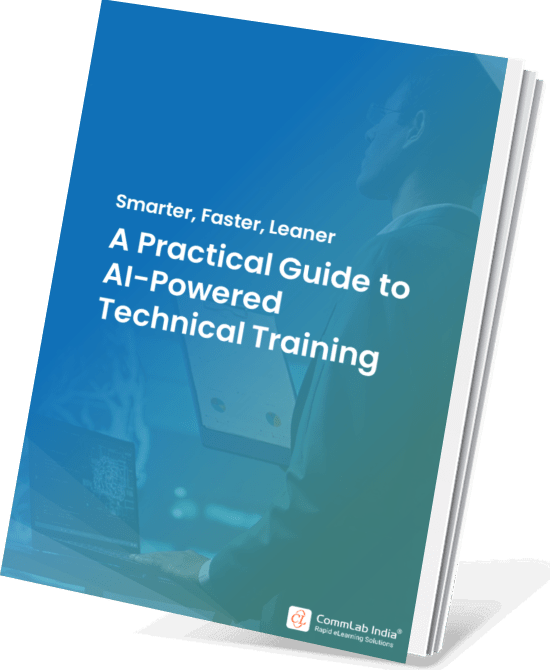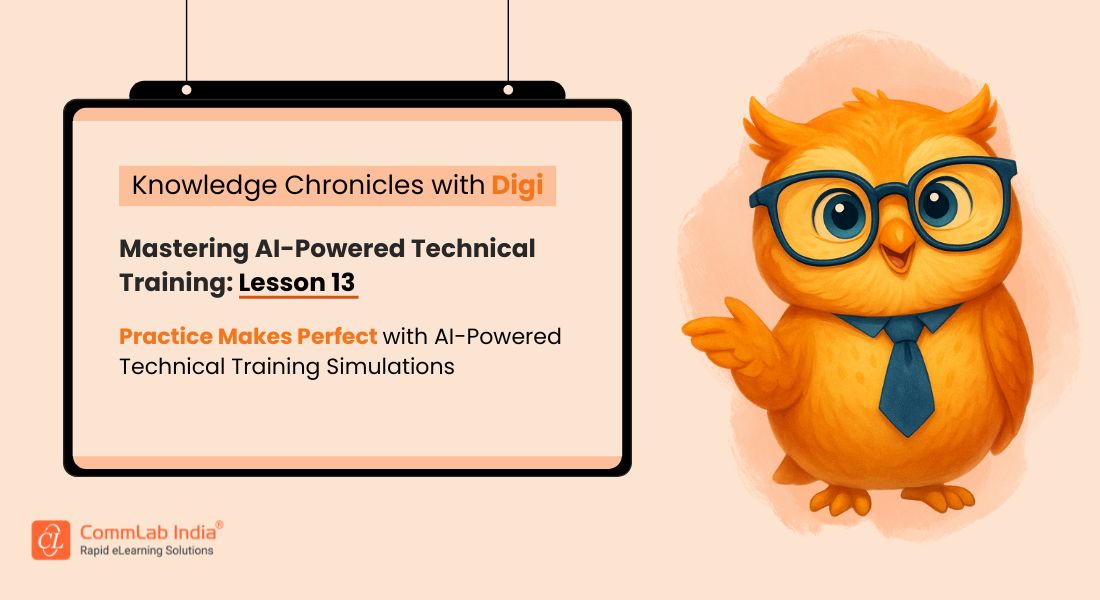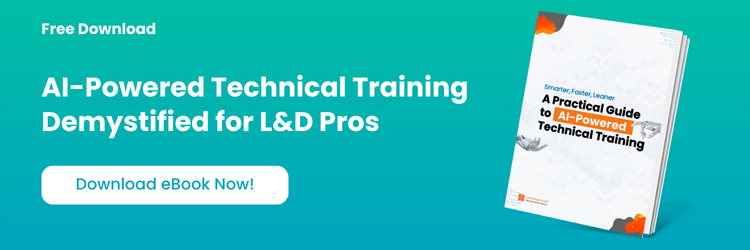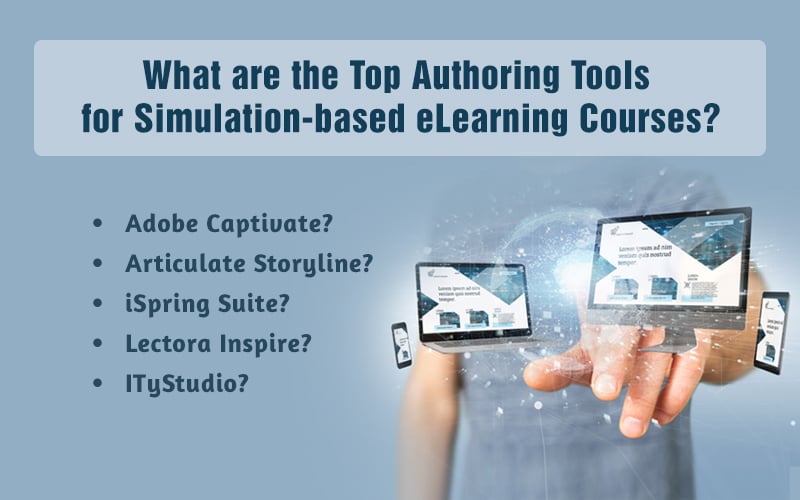In high-stakes environments—think field service, healthcare devices, logistics hubs, or enterprise sales—there’s no room for guessing. Mistakes cost money, time, and sometimes lives. Yet, many organizations still rely on traditional training formats: click-through eLearning, static PDFs, or outdated instructor-led sessions.
The gap is glaring. Your sales and service teams don’t need more content—they need better practice. Enter training simulation.
Download Guide: AI-Powered Technical Training
Thanks to AI, creating immersive, role-specific, and realistic simulations has never been faster or more scalable. What once took months and required game design expertise can now be built in weeks with smart tools and lean processes.
This blog explores how AI is powering next-generation simulations for technical training—and why it’s critical for sales and service success.
TOC
- Why Simulations Matter in Technical Training
- What AI Brings to Simulation Training
- How Simulation Training was Implemented in a Cargo Hub
- How Simulations Work for Training Sales Reps
- How to Get Started with Simulation Training
Why Simulation Matters More Than Ever in Technical Training
Traditional methods fall short:
- ILT can’t recreate real-world chaos
- Standard eLearning lacks nuance
- Roleplays are inconsistent and hard to scale
Simulation training bridges the gap between theory and action. For field engineers, customer-facing reps, or support technicians.
What is the outcome of Simulation Training?
Better judgment, faster reflexes, and improved real-world performance.
Simulation means:
- Practicing decisions in a safe environment
- Applying procedures under pressure
- Handling customer objections or crises with confidence
Here’s a video highlighting the benefits of simulation training.
What AI Brings to Simulation Training

1. Scenario Generation
AI language models like ChatGPT or Claude can:
- Generate realistic sales objection scenarios
- Create field service error-handling narratives
- Tailor situations by persona, geography, or skill level
Prompt example:
“Create a simulation for a field technician repairing a power inverter. Include 3 customer interaction points, one critical safety decision, and a troubleshooting process with branching outcomes.”
2. Branching Logic Automation
Tools like Twine, ChatMapper, or even no-code AI platforms can:
- Auto-build decision trees
- Track paths and consequences
- Score learners based on decision quality
This accelerates what used to require instructional and technical teams working in tandem.
3. Conversational AI for Roleplay
With AI tools like Rasa, Dialogflow, or Rehearsal.ai, you can:
- Simulate sales calls with AI-driven dialogue
- Provide instant, adaptive feedback
- Personalize scenarios per learner performance
For sales reps, this beats passive training videos. They’re practicing conversations with a responsive, always-on coach.
4. Virtual Environments and Visuals
AI tools like Vyond, Synthesia, or Unity (powered by AI-enhanced design) help create:
- Animated installations or repairs
- Product demo simulations
- Scenario visualizations with avatars
Learners engage with scenes that mirror their job sites, customers, or product lines.

Use Case: Cargo Hub Simulation
A global logistics company needed to retrain 600 ground operations staff after two critical near-miss incidents.
Problem:
- Procedures were misunderstood
- Teams lacked confidence in high-pressure scenarios
Solution:
- AI tools generated 10 emergency scenarios
- Branching simulations allowed staff to choose responses to:
- Vehicle breakdown
- Package spillage
- Miscommunication with tower
- Vyond visualized the simulation with real cargo layouts
- MaxLearn pushed follow-up decision drills over the next 4 weeks
Results:
- 89% scenario accuracy in final assessments
- Incident rate dropped by 35% in 2 months
- Learner feedback: “Finally training that feels like my job.”

AI-Powered Technical Training – A Practical Guide
- Training formats that work best for technical learners
- 3-touchpoint model for seamless collaboration with SMEs
- Practical tools and templates
- And More!
Simulations for Sales Reps? Absolutely.
Sales is high-stakes too. A botched conversation can lose a deal or damage brand credibility.
AI-powered training simulation for sales teams:
- Teach objection handling
- Practice negotiation and positioning
- Reinforce compliance with industry rules
Example: A medtech company used AI-generated branching roleplays for their reps launching a high-risk surgical device. Simulations helped them:
- Practice responding to skeptical surgeons
- Navigate legal disclaimers
- Match product benefits to patient outcomes
Deal conversions rose 18% within 90 days of training.
How to Get Started
- Identify High-Stakes Moments
What are the decisions or conversations your team can’t afford to get wrong? - Start with One Role
Don’t boil the ocean. Pick a critical field role or customer-facing segment. - Use AI to Build Scenarios
Feed SME insights into ChatGPT or Claude. Prompt for mistakes, distractions, and escalations. - Build a Minimum Viable Simulation
Use Vyond, Twine, or Synthesia. Start with 3 paths. Iterate from learner feedback. - Measure Impact
Don’t ask, “Did they like it?” Ask, “Did behavior change?” Use performance data, error rates, or NPS.
Final Thought
Simulation training is no longer a luxury. They’re the foundation of performance-driven technical training for people who work in real-world pressure cookers.
AI removes the barriers that kept simulations niche and expensive. Now, every L&D team can design training that prepares sales and service staff not just to know—but to do.
In high-stakes environments, experience isn’t optional.
And with AI, you can give your teams that experience—before the stakes are real.






